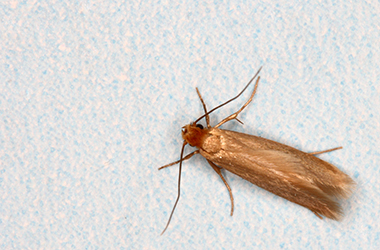
As you start digging through the back of your closet for warmer clothing this fall season, keep an eye out for household pests that may be destroying your clothes.
As you start digging through the back of your closet for warmer clothing this fall season, keep an eye out for household pests that may be destroying your clothes. Even though these pests are not usually disease or germ carriers, their presence can be a nuisance and difficult to eliminate. Its important to ensure your clothes and other fabrics are protected as these pests can cause considerable damage before you even know they are present.
Generally, its the newly hatched larvae that do the damage on everything from sweaters, pants, jackets, wool rugs, to decorative needlework on your walls. Typically insect damage occurs on fabrics containing natural or animal fibers such as wool, mohair, silk, cotton, leather, fur, feathers, down, and any synthetics blended with these natural fibers.
Clothes moths are a light tan color, have very narrow wings, and can grow up to 1/2 inch long. It is the larva (small white worm looking) that actually eats wool garments, not the adult moths themselves. But if you see the adult clothes moths around you can assume they are laying eggs. Clothes moths pose no serious health concern to humans; however, an infestation can quickly ruin rarely used or stored clothing such as old military uniforms, blankets, feathered hats, tuxedos, overcoats, evening gowns, hats, antique dolls and toys, and wall hangings.
They thrive in dark, moist areas, such as closets and attics, where larvae have easy access to food sources like naturally occurring fibers such as wool and cotton. The damage from clothes moths appears as many small holes throughout the garment. Once you identify the presence of clothes moths, it is important to take action immediately. It is rare that infestations will be isolated to one particular location; moths like to travel around the home, searching for new places to lay eggs. Be sure to check carefully to find everything that has been infested. Clean, treat, or get rid of infested items. It may be better to throw out an infested item to protect uninfected woolens.
Washing items in a hot water wash cycle can be enough to kill all life cycles of the moth and ensure pests are removed at all life stages. Conversely, freezing temperatures can also kill any eggs or larvae in your wool garments. Depending on your environment, you can put the clothes outside on a cold day or use a freezer. Getting rid of clothes moths can be difficult so if signs of an infestation are severe enough, seek the help of a pest control professional as additional treatments may be required to eliminate the infestation.
Carpet beetles commonly cause damage to fabrics such as wool, silk, leather, and fur; they do not feed on synthetic fibers. Just like the clothes moth, the carpet beetle larvae are the ones to do the damage to your clothing. Carpet beetle larvae measure 1/8 to 1/4 inch long and appear to be densely covered with tiny hairs or bristles. The garment damage appears in one portion of a garment, or concentrated area. They easily find food in obscure places and can be easily dispersed throughout the home considering their unique ability to travel. Carpet beetles can be difficult to control and can cause extensive damage if left unchecked.
Getting rid of carpet beetles starts by ensuring you remove conditions conducive to infestations. Start by eliminating buildup of lint, dead insects and hair found inside the home. Wash drapes and other washable items in a hot water cycle, as they may contain eggs, larvae, and other adult carpet beetles. To treat items that are stuffed with hair or feathers, simply placing items in a dryer may not be enough you may want to enlist the help of a pest control company. The application of targeted treatments can ensure proper removal throughout the home.
Silverfish are carrot-shaped insects with wingless, flattened bodies that are 1/2 to 3/4 inch long and silver in color. They feed on insulation, carbohydrates, starches, and proteins and both adults and nymphs damage fabrics. They are attracted to and commonly found in natural fabrics such as linen, rayon, and cotton. They require very high humidity or access to water, moderate temperatures, and dark places. Infestations are common around leaking pipes and closet areas.
They thrive on the tiniest scraps of food and once they establish a food source, they will remain and breed in the area. They tend to be most active at night and feed on natural starches and glues, leaving visible damage on finer fabrics such as silk, cotton, linen, and rayon. Silverfish eat at the surface leaving a shaved look, but will usually not leave actual holes in the fabric. Although they prefer starchy food, silverfish are quite able to digest cellulose and will devour your books as eagerly as the food stains on your garments! Your local Truly Nolen pest control company can help you protect your home from outside silverfish intruders.
The most common types of crickets are the field cricket and the house cricket. Crickets are about three-quarters of an inch in length and black or brown in color. Although crickets rarely cause any problems and pose no serious health risks, many people find their chirping annoying. Only house crickets can reproduce inside the home. Cricket infestations are rarely problematic since crickets thrive outside. If crickets are a common disturbance in your home, following up with a pest control expert will help you cricket-proof the interior of your home.
Dont let these fabric-eating pests ruin your winter wardrobe. Want to leave it to the professionals? Contact a trained Truly Nolen pest control expert. Schedule a free inspection today!

As you start digging through the back of your closet for warmer clothing this fall season, keep an eye out for household pests that may be destroying your clothes.